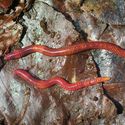When you look at the world around you, how do you categorise or group what you see? One of the broadest groupings is 'living' and 'non-living'. This may sound simple, but it is sometimes difficult to decide whether something is truly alive or not. Here we look at the characteristics of living things – using earthworms as an example.
All living things share life processes such as growth and reproduction. Most scientists use seven life processes or characteristics to determine whether something is living or non-living.
The table below describes seven characteristics of most living things and contains references to earthworms to explain why we can definitely say that they are 'living'.
| Life process | Explanation | Earthworms |
| Movement | All living things move in some way. This may be obvious, such as animals that are able to walk, or less obvious, such as plants that have parts that move to track the movement of the sun. | Earthworms use circular and longitudinal muscles to move through soil or along surfaces. |
| Respiration | Respiration is a chemical reaction that happens within cells to release energy from food. | The food that earthworms eat supplies their body with energy-rich molecules such as glucose. On entering the cells of their body, these molecules are broken down in a series of steps to release energy to be used by the body, producing carbon dioxide and water as waste products. |
| Sensitivity | The ability to detect changes in the surrounding environment. | Earthworms have light-sensitive cells scattered in their outer skin. Their skin cells are also sensitive to touch and chemicals. |
| Growth | All living things grow. | Earthworms hatch from eggs and can grow up to a metre or more in length! Some earthworms are also able to regrow small parts of their body that have been lost or injured. |
| Reproduction | The ability to reproduce and pass genetic information onto their offspring. | Earthworms have both sperm and eggs within their bodies (they are hermaphrodites) but they cannot self-fertilise and need to mate with another individual. After mating, a cocoon containing the fertilised eggs is deposited in the soil. |
| Excretion | Getting rid of waste. | Earthworms excrete waste from their anus – the last segment of their body. |
| Nutrition | The intake and use of nutrients. This occurs in very different ways in different kinds of living things. | Earthworm nutrition comes from a variety of sources, depending on their species. Food types include manure, compost, plant material, fungi, microorganisms and decaying animals. They take in food through their mouths. |
Further classification
Based on the information above, we can confidently categorise earthworms as living things as they carry out all seven life processes.
It is now possible to classify them further into a series of hierarchical categories: kingdom, phylum, class, order, family, genus and species. Classifying living things into these categories is an important way for scientists to show how living things are related to each other. Most scientists classify living things into one of the following six kingdoms.
- Bacteria are single-celled microorganisms that don’t have a nuclear membrane.
- Protozoans are single-celled organisms that are generally much larger than bacteria. They may be autotrophic or heterotrophic.
- Chromists are a diverse group of plant-like organisms and range from very small to very large. They are found in almost all environments.
- Fungi are multicellular and rely on breaking down organic material as they are not able to make their own food.
- Plants are multicellular and autotrophic – they use photosynthesis to produce food using sunlight.
- Animals are multicellular. They are heterotrophic and rely on other organisms for food.
Which kingdom do you think earthworms belong to?
Animal characteristics
What did you decide? Sometimes people are surprised to find out that earthworms are actually animals – the same kingdom as humans, cats, dogs, dolphins and spiders! Just as living things share a set of common characteristics, animals have key characteristics that can help you to decide whether a living thing is an animal or not.
Key characteristics of animals include the following:
- They obtain energy by consuming other organisms (we say they are 'heterotrophic').
- They are able to physically move their bodies about at one or more stages of their life cycle.
- Their bodies are made up of multiple cells.
- Sexual reproduction occurs - a sperm and an egg cell combine to produce an embryo that grows into a juvenile animal.
Nature of science
Scientists need scientific vocabulary to communicate effectively. At an even more fundamental level, scientific language actually helps shape ideas and provides the means for constructing scientific understandings and explanations.
Related content
Read more on the classification system and taxonomy and learn about classifying marine organisms and how scientists classify ferns.
Explore ao Māori understanding of the concept of living and non-living here.
Activity idea
Students can explore their ideas about the characteristics of living things with this graphic organizer, Living or non-living?
Useful link
Visit the Science Continuum website from the Australian education website (Victoria Department of Education and Training) for more information about common student alternative conceptions related to living things and classification.




